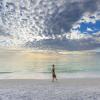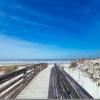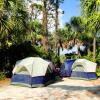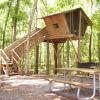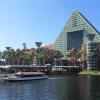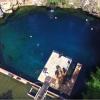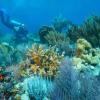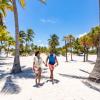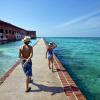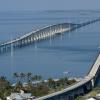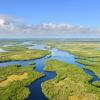A driving tour along the Florida Black Heritage Trail unveils some of the state’s most prominent historic African-American sites.
From the earliest days of territorial exploration in the 16th century, right up to the present day, black history in Florida has been a vital part of the great struggle for dignity and equality. The passionate determination and courage of leaders including Mary McLeod Bethune and A. Phillip Randolph took root in early 20th-century Florida. It gave rise to great institutions of learning as well as impressive African-American achievements in the arts, sciences, athletics and entrepreneurship. This legacy greatly influences the cultural richness of modern Florida.
Experience a few highlights of Florida’s black history during this three-day trip along the east coast and into the central part of the state.
Florida’s Black History Tour: Day One
The adventure begins at Bethune-Cookman University (386-481-2000), in beautiful Daytona Beach. From Jacksonville, you’ll exit off I-95 at exit 261A and drive east on International Speedway Boulevard (U.S. 92) for about five miles. Turn left on Dr. Martin Luther King Jr. Boulevard, and, as you cross Bethune Boulevard, you’ve arrived at the university. Parking is available at the next left near the library, which is opposite the Bethune Foundation and Home. Maps of the 70-acre campus can be obtained at the Bethune Home or from campus security.
The university, one of the most respected historically black institutions of higher learning in the country, was founded by Dr. Mary McLeod Bethune in 1904. Dr. Bethune, the 15th child of freed slaves, began the school with an investment of $1.50 and a total student enrollment of five girls. A pioneer in the civil rights movement, Dr. Bethune was instrumental in developing the national desegregation policy and was among the highest-ranking appointees to President Franklin D. Roosevelt’s Negro Cabinet. She died in 1955, and the exhibits in her home are a testament to her greatness and vision.
Your next stop will be at the Howard Thurman House, less than two miles from the university. Drive south on Dr. Martin Luther King Jr. Boulevard for one mile. Turn left on Cedar Street; after two blocks, turn right on Whitehall Street.
Although not currently open to the public, in 1953, Life magazine called Dr. Howard Thurman (1900-1981) “one of the 12 greatest preachers of the 20th century.” A friend and classmate of Martin Luther King Sr.’s at Morehouse University, Dr. Thurman was a theologian, author of 20 books, one of the most important figures in black history in Florida and the nation and the first African American to hold the post of dean at a predominately white university (Boston University). Thurman traveled widely, meeting Mahatma Gandhi and preaching about racial equality through nonviolent change before Martin Luther King Jr. did. The house was named to the National Register of Historic Places in 1990.
Florida’s Black History Tour: Day Two
Head south on A1A for 12 miles to the quaint, historic town of New Smyrna Beach. Your first stop there will be the Black Heritage Museum, housed in the old Sacred Heart/St. Rita Mission Church building, located at 314 Duss St. The 1899 frame vernacular church now serves as a museum, displaying replicas of inventions and exhibits on the accomplishments of African Americans as well as hundreds of photographs from Chisholm High School, the first Volusia County school for African-American children.
Your next stop will be the African American Museum of the Arts (386-736-4004), located about 25 miles east of New Smyrna Beach in DeLand. To reach DeLand from New Smyrna Beach, take North Duss Street southeast and turn right onto State Road 44/Canal Street. After entering DeLand, turn left onto South Clara Avenue. The museum houses more than 150 African artifacts and a revolving gallery that displays the work of established and emerging artists. The museum is open 10 a.m. to 4 p.m., Wednesday through Saturday.
Within a few minutes’ driving time is the West Volusia Black Heritage Gallery in Bill Dreggors Park (386-740-6813), 230 N. Stone St. Head north on Clara Avenue to West Rich Avenue and make a left. Drive a few blocks, then make a right onto North Stone Street.
The Black Heritage Gallery is located in the Burgess Building, which once housed the DeLand Colored Hospital, the first hospital for African-American residents of Volusia County. There you’ll discover an assortment of memorabilia showing life in the town’s African-American community, including the dental chair used by an early black dentist in the area. Some of the items date from the earliest settlements of freedmen along the St. Johns River. The tour guide’s office is located on the second floor of the main building.
The next stop on the trail is Eatonville, one of the first all-black towns to be formed after the Emancipation Proclamation and the first to be incorporated. It is located just north of Orlando. Get back onto U.S. 17/U.S. 92 and head south for 12 miles to the I-4 interchange. Drive west on I-4 for about 15 miles and get off at exit 88 (State Road 423, Lee Road). Turn left onto Lee Road, take the second left onto Wymore Road and make a right at the first traffic light onto Kennedy Boulevard. After one-quarter mile, you will enter the Eatonville National Historic District (407-647-3307).
From 1880 to 1930, hundreds of communities founded by and for African Americans were established throughout the southern U.S. Few have survived, but Eatonville, now with a population of 2,200, is an exception. The town incorporated in 1887 with an all-black government. Its 230-acre historic district includes 48 buildings constructed between 1882 and 1946.
At the corner of East Kennedy Boulevard and College Avenue is the Zora Neale Hurston National Museum of Fine Arts (The Hurston). Since 1990, the museum has been displaying the visual works of artists of African ancestry, presenting, each season, a minimum of two exhibitionsby artists at various stages of their careers. The Hurston also offers group tours, which introduce Historic Eatonville to visitors. Tours require a fee and are booked by reservation.
Born in Eatonville, Zora Neale Hurston (1891-1960) was a gifted writer and cultural anthropologist who played an important role in the Harlem Renaissance of the 1920s. Although Hurston died in poverty and obscurity in Fort Pierce, novelist Alice Walker in 1975 spearheaded a rediscovery of Hurston’s writing, which now provides inspiration for future generations of writers.Today, Hurston is widely regarded as the most significant interpreter of southern, rural African-American life during the 1920s and 1930s.
A walking/driving tour brochure of the Eatonville portion of the trail can be obtained from the Zora Neale Hurston National Museum of Fine Arts. The second portion of the trail is in Fort Pierce (see the Fort Pierce section in “Day Three” of this tour).
During the last week of January, the Association to Preserve Eatonville Community, Inc. (P.E.C.) presents the Zora Neale Hurston Festival of the Arts and Humanities (ZORA! Festival), celebrating her life and work, her hometown and the contributions of other African Americans. The celebration includes a street festival, traditional foods, vendors, music, children’s activities and educational forums.
Florida’s Black History Tour: Day Three
The next and final destination is the Zora Neale Hurston Branch Library (772-462-2154) in Fort Pierce, where you will pick up the second portion of the statewide Zora Neale Hurston Dust Tracks Heritage Trail. From Eatonville, take I-4 west for 11 miles to the Florida Turnpike; head south on the turnpike for about 100 miles. Exit at County Road 68 (Florida Cracker Trail) and travel east for 1.5 miles. Turn left onto Angle Road for about a half-mile and then right onto Avenue D for another half-mile.
Hurston came to Fort Pierce in 1957 to work as a reporter for the Fort Pierce Chronicle while she was writing her novel “Herod the Great.” The trail will take you on a journey through the final years of Zora’s life, highlighting the places where she taught, lived, worked and now rests. The trail is marked by three colorful kiosks and eight markers.
Also in Fort Pierce is the A.E. Backus Museum & Gallery (772-465-0630), which has a handful of paintings by the Florida Highwaymen, a group of self-taught African-American artists. The Highwaymen painted what interested them in the landscapes with whatever paints and materials were available. Supplies usually included upson board and frames made from doors, ceiling and baseboard moldings. Sometimes with the paint still wet, the artists packed their masterpieces into their cars and traveled about the state peddling their paintings out of their trunks (hence their name). By selling their paintings directly to the public, they created their own opportunities and set the standard for other entrepreneurial African-American artists who began painting Florida landscapes using similar motifs.
Albert Ernest Backus (American, 1906 – 1990) is one of the most renowned and admired of all of Florida’s artists. He came into prominence as a national artist in the 1960s when his work was hung in President Lyndon B. Johnson’s library in Texas and in the Senate offices in Washington, D.C. In 1993, he was inducted into the Florida Artists Hall of Fame.
The museum, which was founded by Backus, opened its doors in 1960 as the Fort Pierce Art Gallery. It was never intended to be a facility dedicated to Backus, but in the days after his death, the Board of Directors renamed the facility as a memorial tribute. For a schedule of upcoming exhibits and events, www.backusmuseum.com.

Zora Neale Hurston Festival
- Contributed Photo

Florida Highwaymen (left to right): Willie Daniels, James Gibson, Mary Ann Carroll, Hezekiah Baker, Roy McLendon
- Contributed photo
Black History in Florida Resources
To request a copy of the Florida Black Heritage Trail brochure, published by the Florida Division of Historical Resources, call (850) 245-6333.
